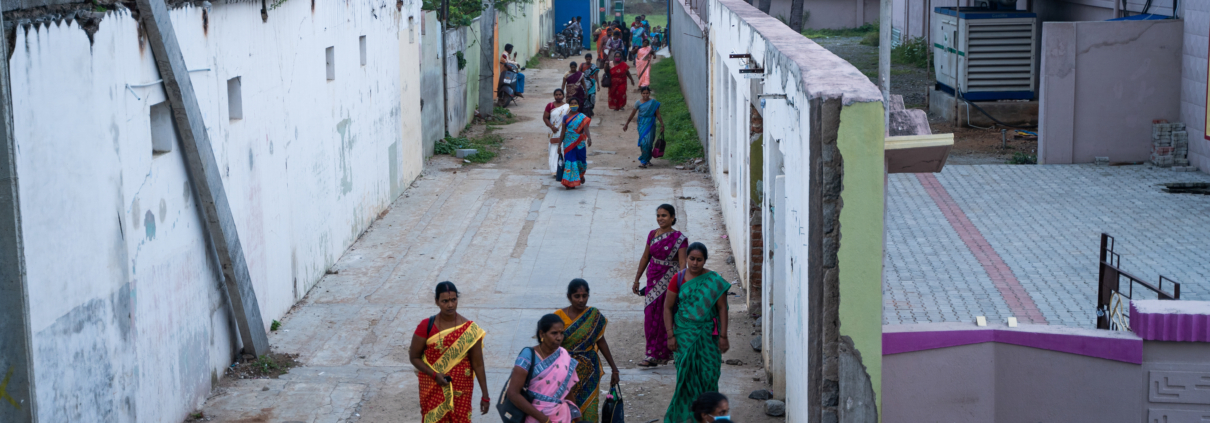Tamil Nadu footwear sector minimum wage revision: A reminder for global brands to pay living wages
Last year, in July 2021, the Tamil Nadu government notified the revision of minimum wages for workers employed in the state’s footwear manufacturing industry. This latest revision, although late by two years, assumes significance as it was announced at a time when workers in the sector were facing enormous hardships. While the state government revised the minimum wages, the key question is whether it is justifiable for the industry to continue to pay workers using minimum wages as the basis when they are still recovering from the debilitating effects of the pandemic?
Revised wages – does it make a difference?
As per the revised rates notified in July 2021, the minimum basic wage rate for an unskilled worker in Ambur is fixed at INR ₹4,843 per month. This is a 24 per cent increase from the basic wage rates fixed for this category of workers in 2014. Similarly, basic wage rates for other categories of workers in the footwear sector have also been increased proportionally. In addition to the increase in basic wage rates, all categories of workers are also eligible to receive a variable Dearness Allowance (DA) which is linked to the Consumer Price Index (CPI). At the outset this increment comes across as a progressive step towards increasing the wage standard for the industry, and any increment is a succour in these pandemic-ridden times. Nevertheless, it is pertinent to look at this wage revision in view of the current economic model.
The pandemic has made visible workers’ vulnerabilities in global supply chains like never before. Several studies have pointed out that low-wage workers do not have any savings to tide over crisis periods and they resort to borrowing money to make ends meet. One of the main reasons for this is the poverty wages that workers receive. It does not allow them to save for crisis periods. Since 2019, the rate of retail inflation in India has been rising consistently. In the last two years the average rate of inflation has been above six per cent. The price of essential commodities such as cereals, pulses, vegetables, fruits, meat and cooking gas has gone up. In light of this economic situation, the revision in minimum wages is nothing more than an eyewash that simply allows workers to sustain their hand-to-mouth existence.
Industry fixation with minimum wages
Low wages are one of the main features of employment in India’s leather and footwear sector. The main reason is that the industry prefers to use minimum wages as the basis for wage payment. Whereas in the footwear sector, a majority of workers are women who are not organised. Their lack of power to bargain makes it impossible to negotiate better wages with employers. This has resulted in stagnation of the wage rate for several years, leaving workers at the mercy of minimum wage rates set by governments.
The Minimum Wage Advisory Board set up by the state government decides the basic minimum wage rates. It follows a set of rigid criteria pronounced in the Minimum Wages Act, 1948. In practice, however, its process has been critiqued for not being completely transparent and for not having enough consultations with workers or their representatives. The very fact that revised wages were announced after a two-year delay, and without any measures to compensate workers for back wages points to this.
While suppliers stick to paying only minimum wages, the shortcomings of this are not completely unknown to international brands who source from footwear units in Tamil Nadu. International brands rely on social audits to ensure compliance with social standards in their supplier factories. These audits use minimum standards prescribed by local laws as indicators of compliance. The result is that such an exercise reinforces minimum wage as the standard wage for supplier factories. Although international standards encourage brands to pay living wages in their supply chains, they have not made any visible efforts to move in this direction.
Paying living wages is the way to go
We know from studies that the purchasing and other business practices of brands, and the standards they adopt to monitor their supply chains have a direct bearing on working conditions in factories. Therefore, shouldn’t living wages be the basis of labour costing in manufacturing contracts, instead of minimum wages? Unless brands address this question, it is very unlikely that suppliers will make real efforts towards paying wages above the minimum floor wage. While there are various efforts by civil society actors to push brands to review their purchasing practices, what is really required are statutory interventions mandating them to pay living wages to workers. The proposed EU-level mandatory Human Rights and Environmental Due Diligence (mHREDD) legislation has a huge opportunity to address this gap. If this law is successful in making it mandatory for brands to ensure payment of living wages, it would pave way for addressing many other connected supply chain-related risks to human rights. In addition, the legislation should also obligate brands to implement effective grievance mechanisms for workers, and ensure that freedom of association is respected. Providing an enabling environment where workers have the opportunity to bargain collectively for better wages will also contribute towards improved working conditions. Finally, a robust and ongoing system to conduct human rights due diligence in supply chains involving all relevant stakeholders would go a long way in mitigating social risks and maximising social outcomes.
This blog is written by Pradeepan Ravi from Cividep


